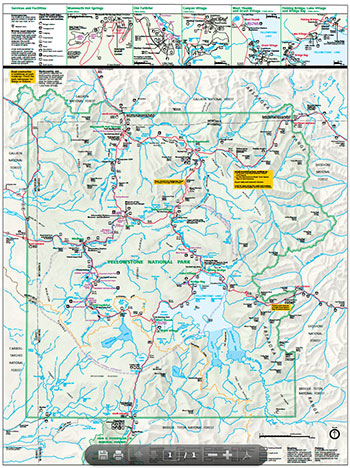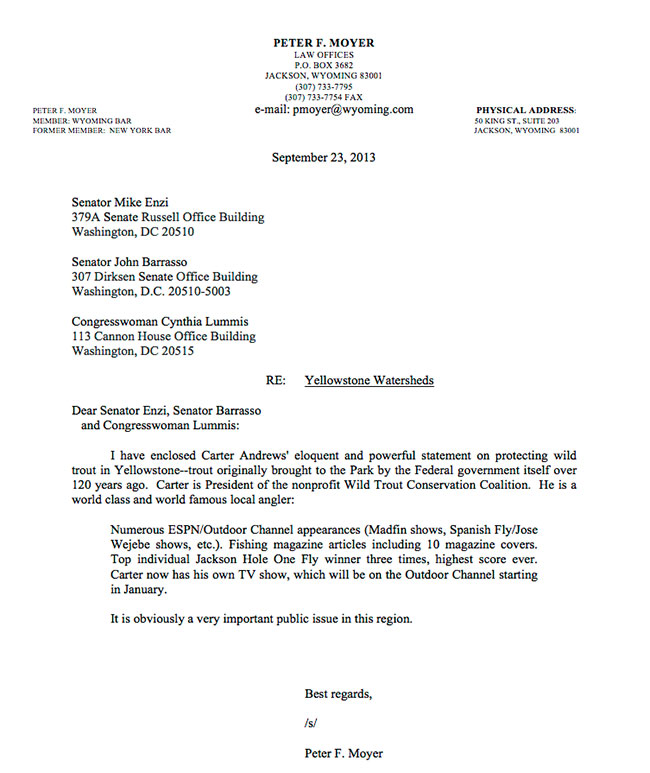 Roughly a month ago I posted a short comment about friends in the Greater Yellowstone neighborhood being vexed by what many have come to see as an overreach by Yellowstone’s Native Fish Management Plan.
Roughly a month ago I posted a short comment about friends in the Greater Yellowstone neighborhood being vexed by what many have come to see as an overreach by Yellowstone’s Native Fish Management Plan.
For (fly) fishers, the wild vs. native fish discussion may well be our Schrodinger’s Cat paradox equivalent, though we’ve been continually amazed by the number and caliber of folks lining up in rational opposition to what’s been happening on a few of the local waterways.
A guide friend who wishes to remain unnamed at this point forwarded over a letter to Wyoming’s Congressional delegation from Jackson Hole legal luminary Peter Moyer (posted below) along with a copy of this piece from Jackson Hole angler Carter Andrews, who among his many activities is President of the (somewhat) recently organized Wild Trout Conservation Coalition. I chatted with Peter via email yesterday and this morning and he graciously gave us permission to post here today and sent over a handful of other information.
This is a fascinating and somewhat troubling read; fascinating given the topic and locale, troubling (at least for this fisher) as it would appear the entire story isn’t being told with regard to management of wild fish and fisheries in the region. While I don’t agree with everything below to the letter, for those interested in the issue this is must see material.
And to stave off comments I’m / we’re turning on TU here with regard to the Lake Trout in Yellowstone Lake issue – nothing could be further from the truth, though I must admit we’re becoming increasing convinced that the entire Lake Trout story hasn’t yet been brought to light.
Protecting Yellowstone’s Wild Trout
As a professional angler, I feel incredibly fortunate to be living in Jackson Hole Wyoming. I arrived in this valley nearly a quarter century ago with the dream of pursuing a career in sport fishing, and as my dreams came to fruition, I never once lost sight of the fact that the greatest wild trout fishing in North America lay right in my own backyard. But as I watch current fisheries management strategies taking effect, I fear that my beloved valley, and the fish species which comprise it, are in grave danger.
Nearly half of the waters that are now encompassed by Yellowstone National Park were originally barren. Over 120 years ago, the Federal government set out to create a sport fishery by introducing game fish species to these waters, in the form of Lake, Brook, Brown, Rainbow, and indeed local Cutthroat trout. Whether by providence or foresight, these early managers set in motion the development of a fishery the likes of which exists nowhere else in the world. These early stockings gained a foothold in Yellowstone and throughout the region, and blossomed into the sustainable populations of wild fish we see and celebrate today. But now, that same government body is hell-bent on un-doing its greatest success.
Until recently, Yellowstone National Park managed its waters with wild trout in mind, namely Yellowstone Cutthroat, Lake, Brown, Rainbow, and Brook trout. A new management campaign undertaken by Yellowstone National Park stands to devastate the wild trout stocks within Park waters, thereby destroying one of the last great wild trout fisheries in the world. The repercussions of this plan will ripple out well beyond Park boundaries.
At the heart of this concern are two primary issues, which I would like to address in turn: the first is the management of Lake trout in Yellowstone Lake, and the second is the management of all other trout in Park waters.
Lake trout management in Yellowstone Lake has become a controversial issue. The Yellowstone Park Service, bolstered by certain scientists under its jurisdiction, is blaming the Lake trout for the decline of Yellowstone Cutthroats in Yellowstone Lake. The Park Service claims that this decline took rapid effect after Lake trout were introduced to Yellowstone Lake in the 1980s. Oddly, however, Park records (entered by a high-ranking Park official and its chief historian) indicate that the Federal government first introduced Lake trout into Yellowstone Lake in 1890. In the ensuing years, Lake trout have managed to thrive in harmony with other representative species, and the fishery on a whole has flourished. Though I am not denying that Yellowstone Cutthroat suffer some predation by Lake trout, empirical evidence would prove it to have minimal impact. I have personally killed and cleaned well over 100 Lakers for consumption over the years, and I have yet to see remains of even one Cutthroat in the stomach of any of these fish. Quite to the contrary, the vast abundance of aquatic feed in evidence has been in the form of leeches and scuds. In a more formulaic example, stomach sampling of 271 Lake trout from nearby Jackson Lake revealed that only one Cutthroat trout was found. Many anglers will confirm that the Park=s science here is illogical. Lake trout and Yellowstone Cutthroat occupy radically different places in the water column, and their habits rarely coincide. While Lakers reside in the deep, cold sections of stillwater ponds and lakes, Cutthroats cruise the higher zones, well out of range of the majority of Lake trout. Do the species ever overlap? No doubt it happens, but the negative incidence of such an encounter is infrequent at best, and the species co-exist in harmony throughout numerous regional lakes.
Despite this evidence, the Yellowstone Park Service has instituted a killing campaign in Yellowstone Lake. A team of commercial fishermen has been hired to string gillnets across Yellowstone Lake in order to corral the very fish that the Park itself introduced, no doubt creating a by-catch that goes unmentioned. So doing, the Park Service is effectively destroying a fishery of great aesthetic, recreational, and economic value. As a counterpoint, 40 miles away in Grand Teton National Park, the Park Service manages Jackson Lake as a trophy Lake trout fishery, even going as far as to close the season for Lake trout during their spawn. Yellowstone Cutts subsist in Jackson Lake too, bearing witness to the fact that even a water body managed to increase Lake trout size and numbers can maintain a healthy population of Cutthroats. The fact that fish numbers in Jackson Lake seem unaffected should be proof enough of the absurdity of the Yellowstone Lake management plan.
As if the simple reality of the killing campaign that the YNPS has waged on the Lake Trout were not disgraceful enough, the ethics of the campaign are notably shameful. After Lake trout are netted, the sub-contracted Park netters puncture their swim bladders and send them to the bottom of the lake, while mandating that all anglers who catch Lake trout do the same. Imagine a game fish being treated like this in the name of conservation? It seems that, in the worst case, 1.2 million wild Lake trout could be put to good use, rather than destroyed and cast overboard. But if the corporal waste were not enough, the expense of this campaign is a heart-wrenching $2.3 million per year. Though there are budgets being cut all across the parks, and fat is being trimmed in the name of the national good, this bizarre enterprise has not been touched.
I am all about saving the Yellowstone Cutthroat, but I contend that there are many more issues besides Lake trout predation that contribute to their decline. The most glaring of impacts is the fire season of ‘88. The Park’s own records reveal that Cutthroat numbers have declined 65% in the years immediately following the ‘88 fires. The devastating heat generated by wildfires that year reeked havoc on spawning tributaries of Yellowstone Lake, and the encompassed ecosystem saw a massive die-off of nearly all species. In some of these places, very little has come back. Tributaries used for spawning habitat by Yellowstone Cutthroat were silted as a result of ash and loss of cover, which effectively devastated spawning runs. To add insult to injury, Whirling disease and warming trends further impacted the viability of spawning stocks, limiting overall numbers of spawning fish in the system. Rather than demonize the Lake trout, a great solution to declining Cutthroat numbers (and one of far lesser expense to taxpayers) might be a restoration of spawning habitat and the addition of rearing boxes, which incidentally have been proven to substantially increase spawning success. If our collective goal is to save the Yellowstone Cutthroat, let’s start by addressing some real problems.
As I mentioned earlier, there are two issues impacting wild trout in YNP. The second of these issues lies in the Park Service’s recent decision to take the Park waters back to their original state. This effectively means killing many of the wild trout stocks within park waters, with the supposed hope of reestablishing indigenous species. The Park has spent the past one hundred years and countless dollars stocking Brown, Rainbow, Lake and Brook trout in waters that originally had no trout. They should be commended for the tremendous work of creating one of the greatest fisheries in the Rocky Mountains. But now arises this new policy, indicating that those hard-won wild trout are non-native, and therefore do not belong in YNP. The Park Service has a long list of waters they intend to kill; this campaign has already started. Under this poisoning program, nearly every living body in a watershed is killed. High Lake was barren before the Federal government stocked it with Yellowstone Cutthroat over 75 years ago. Just recently, High Lake was poisoned. The Park is effectively killing the same trout they are trying to protect. Grayling Creek was poisoned and there are loads of others on the list. What next, the Gibbon, the Lamar, the Bechler? These fish and these fisheries, though not entirely native, have become over the last century as wild as nearly anything in our great American West. They have a place, their serve a purpose. I believe YNP and its personnel need to be more accountable for their actions. It will take support of all of us to save the Yellowstone Cutthroat as well as all the other wild trout in this magnificent National Park.
I am, at heart, a passionate fisherman. But as a passionate fisherman, I am physically and intimately involved in our fisheries resource on a daily basis. I am invested because I am out there in it, seeing the problems as they arise, and seeing the success, or devastating failures, of our management policies. There is bad science and bad management at work with regard to the killing of wild trout in Yellowstone, and it falls in direct opposition to the approach taken in Grand Teton National Park. We as a people are currently witnessing the largest and most aggressive trout killing campaign in our nation’s history, and it is taking place in the oldest and greatest of our National Parks. I for one am committed to seeing a change.
Carter Andrews, President
Wild Trout Conservation Coalition


